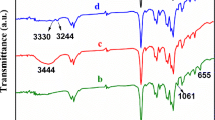Abstract
Interaction of organism with non-toxic implanted polymers depends on the physicochemical properties of the implant surface, which influence the adsorption of bioactive proteins and subsequently adhesion and growth of cells. The synthetic hydrogels are known as poorly adhesive surfaces. In this study we demonstrated the adsorption of albumin, fibrinogen, fibronectin, basic fibroblast growth factor, heparin-binding epidermal growth factor-like growth factor and epidermal growth factor to poly(2-hydroxyethyl methacrylate) (pHEMA) and copolymer of 2-hydroxyethyl methacrylate (HEMA) and potassium salt of 3-sulfopropyl methacrylate (SPMAK). The adhesion and growth of 3T3 cells and human keratinocytes on surface of these polymers was tested without and with pretreatment of polymers with heparin-binding epidermal growth factor-like growth factor. The adhesion of mixture of human granulocytes and monocytes to these surfaces was also tested. The strips of both polymers were subcutaneously and intracerebrally implanted into the rat and the extent of foreign body reaction and brain biocompatibility was evaluated. The results showed the extensive adsorption of basic fibroblast growth factor and heparin-binding epidermal growth factor-like growth factor to copolymer containing SPMAK. However the adhesion (and growth) of cells to this type of copolymers was very low. Preadsorption of human plasma to pHEMA clearly stimulated the leukocyte adhesion in contrary to copolymer containing SPMAK. The extent of foreign-body reaction was significantly higher against the pHEMA compared to tested copolymer p(HEMA-co-SPMAK). In conclusion, the tested copolymer was a poorly adhesive substrate that is only poorly recognized by the non-specific immunity, although the adsorption of basic growth factors to this substrate is highly significant. Both polymers were well tolerated by the brain tissue. The phenotype of surrounding neurons was more close to the control neurons in the brain tissue surrounding the p(HEMA-co-SPMAK) implants. © 2001 Kluwer Academic Publishers
Similar content being viewed by others
References
K. Smetana Jr., Biomaterials 14 (1993) 1046.
J. E. Babensee, J. M. Anderson, L. V. Mcintire and A. G. Mikos, Adv. Drug Delivery Rev. 33 (1998) 111-139.
L. Tang and J. W. Eaton, J. Exp. Med. 178 (1993) 2147.
L. Tang and J. W. Eaton, Cells Mater. 4 (1994) 429.
L. Tang and J. W. Eaton, Am. J. Clin. Pathol. 103 (1995) 466.
A. K. Mcnally and J. M. Anderson, Proc. Natl. Acad. Sci. USA 91 (1994) 10119.
J. M. Anderson, N. P. Ziats, A. Azeez, M. R. Brunstedt, S. Stack and T. L. Bonfield, J. Biomater. Sci. Polymer Edn. 7 (1995) 159.
K. Smetana Jr., M. JelÍnkovÁ, J. VacÍk and M. NovÁk, J. Mater. Sci. Mater. Med. 6 (1995) 32.
F. Grinnell and M. K. Feld, J. Biol. Chem. 257 (1982) 4888.
K. Smetana, Jr., J. VacÍk, D. SouČkovÁ, Z. KrČovÁ and J. Šulc, J. Biomed. Mater. Res. 24 (1990) 463.
M. JirouŠkovÁ, J. BartÚŇkovÁ, K. Smetana Jr., J. LukÁŠ, J. VacÍl and J. E. Dyr, J. Mater. Sci. Mater. Med. 8 (1997) 19.
K. Smetana Jr., J. LukÁŠ, V. PaleČkovÁ, J. BartÚŇkovÁ, E.-T. Liu, J. VacÍk and H.-J. Gabius, Biomaterials 18 (1997) 1009.
K. Smetana, Jr., J. VacÍk, M. Houska, D. SouČkovÁ, J. LukÁŠ Macrophage recognition of polymers: effect of carboxylate groups. J. Mater. Sci. Mater. Med. 4 (1993) 526-529.
K. Smetana Jr., J. VacÍk, D. SouČkovÁ and Š. PitrovÁ, Clin. Mater. 13 (1993) 47.
S. ŠevČÍk, J. VacÍk, D. ChmelÍkovÁ and K. Smetana Jr., J. Mater. Sci. Mater. Med. 6 (1995) 505.
H. Kresse, in “Glycosciences. Status and Perspectives”, edited by H.-J. Gabius and S. Gabius. (Chapman & Hall, London) pp. 201-222.
K. Smetana Jr., Exp. Molec. Pathol. 46 (1987) 258.
E. FifkovÁ and J. MarŠala, in “Electrophysiological Methods in Biological Research”, edited by J. Bureš M. Petráň and J. Zachar (Prague, Pub. House of Czechoslovak. Acad. Sci., 1967) pp. 653-731.
L. W. Swanson, “Brain Maps: Structure of the Rat Brain” (Elsevier, Amsterdam, London, New York, Tokyo, 1992).
U. Scherer-Singler, S. R. Vincent, H. Kimura and E. G. Mcgeer, J. Neurosci. Meth. 9 (1983) 229.
P. PetrovickÝ and V. NĚmcovÁ, J. Brain Res. 36 (1995) 539.
P. B. Gordon, H. U. Choi, G. Conn, A. Ahmed, B. Ehrmann, L. Rosenberg and V. Hatcher, J. Cell. Physiol. 140 (1989) 584.
E. Ruoslahti, Y. Yamaguchi, A. Hildebrand and W. A. Border, Cold Spring Harbor Symp. Quant. Biol. 57 (1992) 309.
C. J. Dowd, C. L. Cooney and M. A. Nugent, J. Biol. Chem. 274 (1999) 5236.
Author information
Authors and Affiliations
Corresponding author
Rights and permissions
About this article
Cite this article
Lukáš, J., Smetana, K., Petrovický, P. et al. Biological properties of copolymer of 2-Hydroxyethyl methacrylate with sulfopropyl methacrylate. Journal of Materials Science: Materials in Medicine 12, 639–646 (2001). https://doi.org/10.1023/A:1011297828955
Issue Date:
DOI: https://doi.org/10.1023/A:1011297828955




